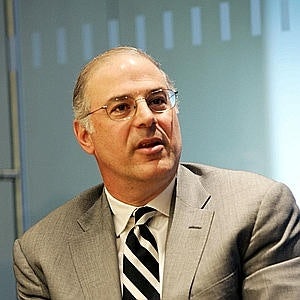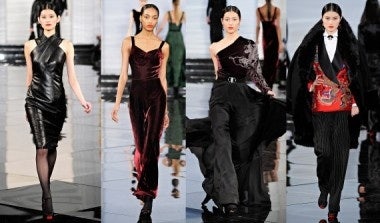Is Ralph Lauren A Late Mover?#

Roger Farah, president of Polo Ralph Lauren, eyes on China (Image: Reuters)
Jing Daily has previously noted Ralph Lauren's plans to open 15 new stores annually in China over the next several years as part of an extended rollout. Considering the popularity of Americana-infused style -- and the ubiquity of the classic polo shirt -- in China, Lauren's prospects in China have appeared more or less rosy. However, recently we've noticed an increase in the number of Chinese-language articles that have called Ralph Lauren a "late mover" and questioned his potential for success in China.
Compared to other fashion brands like Burberry and Mont Blanc, which have, in the last few years, abandoned the brand owner-agent model and set up dozens of new wholly owned stores throughout China, Ralph Lauren currently has only three stores (and one outlet) in mainland China, split between Beijing and Shanghai.
In the United States and Europe, Ralph Lauren has been ranked among the top premium brands for over 40 years. In 2010, Ralph Lauren beat out luxury giants like Louis Vuitton and Burberry for the top 2010 Luxury Marketer nod, one of the most prestigious awards in the luxury marketing industry. However, in Asia the New York-based lifestyle brand is typically considered a mid-level brand. This is particularly in China, even though the brand is, in many ways, just now reaching that market. According to local Chinese media, due to less-than-successful brand management over the past few years, Ralph Lauren has missed an opportunity to position itself firmly as a luxury brand among Chinese consumers. Chinese-language news sources have additionally called attention to the company's notoriously sharp public conflicts with local brand agents.
As Jing Daily previously pointed out,
Usually, in the early days, foreign luxury brands owners would completely cede a given market to an agent when first entering the Chinese market. These agents, in order to push higher profits, would then commonly set prices for these luxury goods at 4.2 times cost.
However, it appears that the era of the luxury agent is in a state of steady decline, as many major luxury brands -- having gained greater consumer awareness in China -- have recently decided that they're no longer willing to share a piece of the pie with extraneous (and expensive) agents. As a result, these brands have seen profits rise steadily, and have plowed this revenue into their expansion efforts.
Having encountered serious speed-bumps in its China expansion efforts, Ralph Lauren has taken a number of measures designed to improve the company's image and raise consumer awareness. From the Chinese-language portal JRJ Finance (translation by Jing Daily team):
In mid-2009, in order to re-establish a new business model for the Chinese market, Ralph Lauren spent several million dollars employing a prestigious global consulting firm to research and re-evaluate the market. However, after nearly two years, the plan has not yet been implemented, which is an incredibly slow response for a well-known fashion brand in such a fickle market. The main reasons are probably due to irreconcilable conflicts between the brand and its agents.
Ralph Lauren's three major product lines in China are his Purple Label, Black Label and Blue Label, and each of them occupies a different market segment, such as luxury, the relatively expensive high-end business segment, and more youth-oriented fashion. However, each of these product lines has simply been mixed together by Ralph Lauren's local brand agents, with pricing being chaotic and irrational. As more low-end items were sold with other higher-end lines, Chinese consumers became confused, a development that has further damaged Ralph Lauren's brand image.
Up 'til now, many Chinese consumers have confused Ralph Lauren's products for counterfeit Polo shirts, which have been rife in the China market for years. Also, Ralph Lauren's local agents have failed to be restrictive when choosing locations in China. They failed to take golden opportunities available in top-tier cities, instead blindly selling in second- and third-tier cities. As a result of this vague positioning, the brand has found that it's difficult to gain a strong customer base.
The case can be made that it's not the responsibility of a brand's local sales agents to build a brand's image, but rather just to sell as many products as possible. But the case can also be made that Ralph Lauren has been very sluggish to take more direct action in setting up stores in China, especially compared to quick-moving competitors. However, it's better late than never.

Ralph Lauren's China-inspired F/W 2011collection (Image: Beautyisdiverse.com)
In an effort to catch up, the company recently launched a series of China-focused marketing strategies, which Jing Daily has previously profiled. In February, Ralph Lauren debuted a China-influenced Fall/Winter 2011 collection featuring Chinese elements reflected through an Art Deco lens, worn by a number of Chinese supermodels as they tred the runway while a cover version of David Bowie’s “China Girl” played over the loudspeakers. While this display made many cringe, it showed that the company at least has understood the fact that they must make some kind of overture to the Chinese market, ham-handed or not. At the same time, Roger Farah, president of Polo Ralph Lauren, said the brand was looking to expand in Beijing and Shanghai, as well as second- and third-tier cities.
In an effort to drive up sales and solidify the Ralph Lauren name in China, the company aims to tap into China’s recent upsurge in e-commerce. However, we'll have to wait and see how these plans pan out. Though e-commerce is a hot topic among major brands now looking to capture more of the China market, it's still a relatively new and untested arena.
Unfortunately, considering the speed at which Chinese consumers are developing brand awareness and taste, muted chinoiserie and an online presence won't be enough. Ralph Lauren's got serious competition in China, and lately it seems that international brands are trying to out-lavish each other in Beijing, despite the fact that "luxury" is now a four-letter word there. Recently, Burberry pulled out all the stops for a holographic runway show celebrating the launch of its massive new Beijing flagship, in an attempt to appeal to China's wealthier, younger consumers. Interestingly enough, Ralph Lauren made news last year with the world's first 3D fashion show, which the company projected onto the façade of its Madison Avenue flagship in New York. It's perhaps regrettable that we've not yet seen Ralph Lauren integrate this kind of activity into their China strategy, just another indication that the company is moving more slowly than its competitors in appearing truly "plugged in" to China.